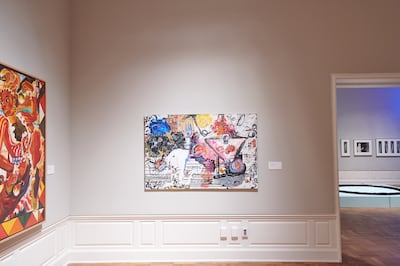This story is published in cooperation with Willamette Week and Portland Art Museum.
Now through March 17, 2024, Portlanders can experience Black Artists of Oregon, an intergenerational art exhibition on display at the Portland Art Museum. The exhibition—curated by interdisciplinary artist Intisar Abioto, whose work is considered by many to be a legacy in Portland’s Black community—is the first of its kind to consider the work of Black artists collectively in Oregon.
Beginning in the 1880s and spanning through today, Black Artists of Oregon “captures the Black diasporic experiences particular to the Pacific Northwest with 69 artists and over 200 objects.” According to PAM, though particular attention is given to the works of Black artists who were producing work during the Black Arts Movement of the late 1960s, the exhibition will also include the works of contemporary and younger artists working now.
Two such modern artists represented in the exhibition include MOsley WOtta and Sadé Duboise.
Jason McNeal Graham, aka MOsley WOtta/ MOWO, is a painter, writer and performer. He’s a Central Oregonian turned Portlander, originally from Chicago, whose move to Oregon has continued to influence his creative work. MOsley WOtta’s piece featured in the exhibition is entitled Baba Was a Black Sheep.
 Opens in new window
Opens in new window“The painting references my father’s experience of feeling separate or outcast because his experience didn’t fit into any one box as a black man,” says MOsley WOtta. “More broadly, this piece is challenging and critiquing metrics of inclusion themselves. In my experience, we are all the odd ones out. I want to normalize the so-called abnormalities.”
He says he hopes Black Artists of Oregon inspires viewers to create their own work and tell their own stories “regardless how unconventional their story or style may appear.”
Painter Sadé Duboise was born and raised in North Portland. Duboise says that her exposure to Black artists was limited growing up. As she was about to graduate from high school, however, her mother introduced her to the work of Arvie Smith.
“The revelation was profound. Here was this amazing Black artist, not just anywhere, but right in the Portland metro area,” Duboise says. “He became the first painter I truly recognized and resonated with, and later took my first painting class with before I even enrolled at [Pacific Northwest College of Art].”
 Opens in new window
Opens in new windowDuboise acknowledges that being a Black artist in Oregon carries its own set of unique challenges, brought on by the state’s racist history.
“Historically, there’s been a palpable lack of interest in Black people, let alone Black artists,” Duboise says. “It took a heart-wrenching event, the tragic demise of George Floyd, and the subsequent global protests, for the world to sit up and take notice of Black artists and the profound narratives behind their creations.”
This attention, while rooted in tragedy, has had its silver linings, she says. For Duboise, it paved the way for scholarships that supported her education in painting, opened doors, and culminated in having her work featured in the Black Artists of Oregon exhibition. One such piece now on display at PAM is called Black Tears.
“[The piece] portray[s] a Black woman in the throes of sorrow, mirroring my own emotions as I grappled with the reports of police brutality,” Duboise says. “The matte black in the painting symbolizes the collective identity of Black people.”
For Duboise, being a Black artist in Oregon “transcends mere identity; it’s a realm of wonder.”
“It signifies a deep sense of community with fellow artists, a life steeped in creativity, moments of rest, pathways to healing, and an embodiment of beauty and inspiration,” she says. “Above all, it represents the indomitable spirit of perseverance for me.”
Portland Art Museum will host the Black Artists of Oregon exhibit through mid-March 2024. You can learn more about the exhibit and plan your visit at portlandartmuseum.org/event/black-artists-of-oregon.

